[ad_1]
Some magic hides in plain sight. Take the languages we speak. Each word represents not only itself — intricate, complicate, duplicate, communicate — but also the story of how that word came to be. With English, the story is intricate enough. The 1.7 lakh words in the dictionary come largely from Greek and Latin, with new words being added from as far away as Korea, Zimbabwe and Tahiti.
With Indian languages, the trails are shorter but delightfully tangled. “There has been so much exchange in the last 1,000 years that every language here has a shared history,” says Abhishek Avtans, lecturer of Indic languages at Leiden University in the Netherlands. “Hindi and Urdu words derive not only from Sanskrit but Pali, Prakrit, Tamil, Kannada, Portuguese, English, Persian and Arabic too.”
There are Frankish words from a West Germanic language that is at least a thousand years old. “It is from ‘Frankish’, in fact, that we get the word ‘Firangi’ for foreigner,” Avtans says. “Many other words come from ancient Dravidian languages that have evolved into modern south Indian lects or tongues. It makes etymology of Indian words much more complex.”
But it also gives the Indian tongue a unique flavour. “We have echo-formations… gaadi-vaadi, tana-bana, theek-thaak. We often re-duplicate for emphasis: Bade bade deshon mein aisi chhoti chhoti baatein, hoti rehti hai (Such little-little things keep happening in big-big countries),” Avtans says, quoting from the film Dilwale Dulhania Le Jayenge (1995).
Avtans’s linguistics research has taken him to the foothills of Meghalaya, where Jaiñtias speak an Austroasiatic language called Pnar, and to the Andamans, where language has literally saved lives. The Great Andamanese have a folktale that has been passed down through generations. Essentially, its message is: When the ocean recedes from land, run to the hills. “It’s what made the community take shelter ahead of the 2004 tsunami,” he says. “All of them survived.”
And so ancient wisdom, hard-won, is preserved and passed on. Ancient trade routes rear their heads, in linguistic milestones. Practices long dead become footnotes in how we name or describe an object. See why ganjī is ganjī, and not remotely an Indian-origin word for vest. Find out why our words for sugar are both “Egyptian” (“misrī”) and “Chinese” (“chīnī”). See how a Dravidian Jack gave the jackfruit its name, and meet its fruity seafaring cousin.
Social media has brought languages closer, says Avtans. On Twitter (@avtansa), he regularly fields requests from Indians who want to know more about the words we take for granted. He upset Punjabis by telling them that kuṛī, the local term for girl, is of Dravidian origin. Other language enthusiasts have been translating Urdu couplets, Dakkani idioms and posting videos on pronunciation.
“A language is more in the mouth than in the books,” Avtans says. Over the years, his list of everyday words with surprising histories has only got longer.
Take a look at Avtans’s list of some of the most interesting journeys words have taken to arrive on Indian tongues, and to travel from our lexicons to languages around the world.
.
Ilāyachī (cardamom)
The ubiquitous spice found in everything from garam masala powder to mithai has its origin in a Dravidian language source word, ēl (cardamom), which was borrowed into Sanskrit as ēlā. Compare the words for cardamom in Tamil (ēlakkāy), Kannada (ēlakki), Tulu (ēlakki) and Malayalam (ēlatt-ari). It is not surprising that cultivation of ilāyachī is concentrated in the evergreen forests of the Western Ghats in South India. Even the modern botanical name of green cardamom, Elettaria cardamomum, has preserved the Dravidian root.
.
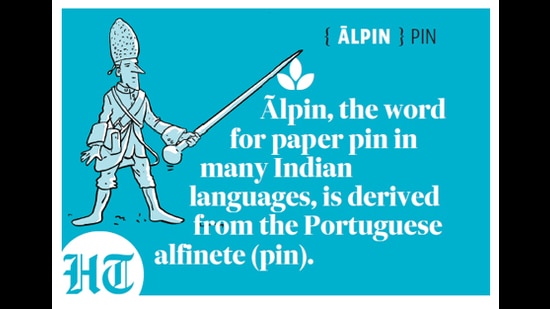
Ālpin (pin)
From the 16th century on, as Portuguese traders and colonialists settled in the subcontinent, Indian languages began to draw from Portuguese. Many words for common objects in particular were borrowed. Ālpin, the word for paper pin in many Indian languages, is derived from the Portuguese alfinete (pin), which is ultimately from the Andalusian-Arabic al-ḵilāl (pin / peg). Andalusian Arabic was a variety of the Arabic language spoken in Spain and Portugal during the period of Moorish domination and influence, from the 8th to 14th century. Incidentally, the Malaysian peniti (pin) comes from the same Portuguese source.
.
Ṭharkī (lewd person)
This is a word used for a person who is lewd, lustful, has vain desires. The word is drawn from the Punjabi ṭharak, which means desire or habit. So, the verb ṭharaknā in Punjabi means to have vain desires, to be shaken. In Dogri and Punjabi, tharkī is also an addict or slave of some habit. In modern slang, it is generally used to indicate that a person is an addict or a pervert.
.

Kuṛī (girl)
One of many popular words drawn from Punjabi, kuṛī simply means girl. A similar word is used in Kashmiri (kūr). Both words are linked to a North Dravidian source word for “young” or “youth”. It’s a word that endures in Tamil (“kur̤a” is “young”), Kannada (“koḍa” is “youth”) and Telugu (“kurra” is “young”). The word is immortalised in Punjabi poet Shiv Kumar Batalvi’s 1970s song, Ikk Kuṛī Jidā Nām Mōhabbat (A Girl Whose Name is Love).
.
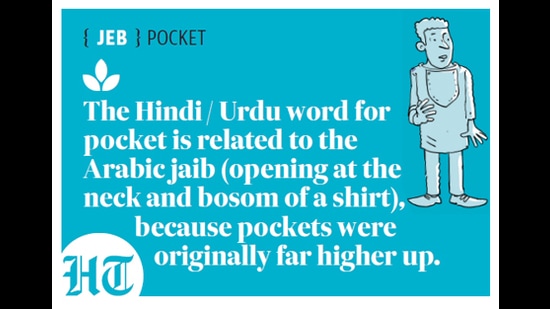
Jeb (pocket)
The Hindi / Urdu word for pocket is related to the Arabic jaib (opening at the neck and bosom of a shirt). The use of jeb for pocket caught on because pockets were originally far closer to the neckline. Even when they moved to the chest and then the hips of trousers, the word stayed. Interestingly, the Hindi / Urdu word for collar or cloth around the neck is the Persian garebān or girebān, which has its origins in the Sanskrit grīvā́ (neck).
In an interesting instance of loaning, the word for buttonhole in several Indian languages draws from the Portuguese “casa de botão” (house of the button). But the Indian languages borrowed just the first element — and so button hole is kāj ghõr in Bengali, kāj in Hindi / Urdu and gājā in vernacular Tamil, all of which just draw on the house bit. The Bengali, in fact, would translate literally as “house house”.
.
Pājī (mean person)
Paji is literally foot-soldier. It comes from the Sanskrit padya (foot-related), and pājī was the term for infantryman in medieval North India. Since infantrymen often harassed commoners, the word acquired a negative connotation and remains synonymous with scoundrel. It has the same meaning, in fact, in Persian.
Interestingly, it bears no relation to the Punjabi word that is pronounced pājī but is actually bhrājī (for brother), from the Sanskrit bhrātā (brother). How did bhrājī become pājī? In Punjabi, there is a tendency to not pronounce bh. So bhrājī becomes prājī becomes pājī.
.
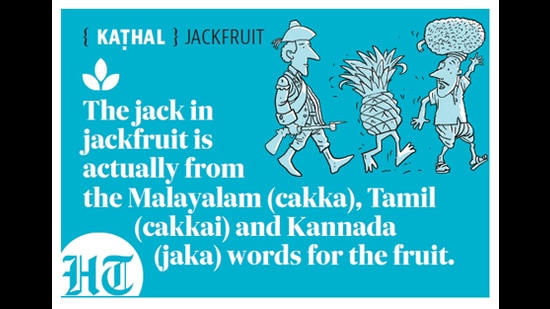
Kaṭhal (jackfruit)
This is an interesting one because jackfruit actually draws from a Dravidian source, and kathal from Sanskrit. Compare the words for jackfruit in Malayalam (cakka), Tamil (cakkai), Kodagu (cakke) and Kannada (jaka) and you see how the English, arriving in India, ended up at jackfruit. In Sanskrit, the fruit was called kaṇṭaphala. And from there comes the Hindi / Urdu and Bengali kaṭhal.
Interestingly, by the late 1500s the pineapple was being called kaṭ’hal-i-safari, or travelling jackfruit, likely because of a practice of planting pineapples in pots, to mature en route as ships sailed to faraway lands.
.
Chaḍḍī (underwear)
One of the oldest words for loincloth in India is langōṭ, whose smaller form is langōṭī. Langōṭ is related to the Sanskrit liṅgapaṭṭa (loincloth), with liṅga being genitals and paṭṭa being cloth. Kacchā, another word for underwear, comes from the Sanskrit kakṣyā (girdle, girth). Chaḍḍī, or underwear, probably comes from the Sanskrit word chanḍātak, which was a short skirt worn by women as innerwear.
.
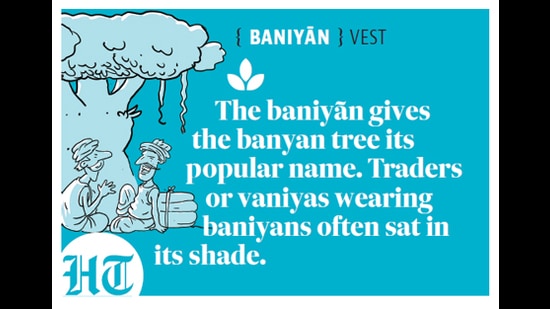
Baniyān (vest)
Baniyān is a word which travelled all over and came back to India with a new identity. It is derived from the Sanskrit vaṇijaḥ (merchant, trader). It entered Portuguese as banian, borrowed from the Sindhi vāṇyāṇī and Gujarati vāṇiyo. In English, banian became the term for a loose gown or shirt of flannel, because this kind of innerwear or nightwear resembled shirts worn by Indian baniyās or merchants in colonial India. These traders often sat in the shade of the Indian fig tree Ficus benghalensis, which is why it began to be called the banyan tree.
Incidentally, ganjī for cotton undershirt is not of Indian origin. It comes from Guernsey, an island in the English Channel that first made a seaman’s knitted woollen sweater that came to be called the Guernsey.
.
Tauliyā (towel)
This word has its origins in a Germanic language and arrived in India via Portuguese. Tauliyā is from the Portuguese toalha, which in turn comes from the Old Portuguese toalla, which has its roots in þwahila, from the 5th-century Germanic Frankish language. India has equivalents, of course: angochā and gamchā, which come from the Sanskrit aṅgoccha (towel).
.
Kainchī (scissors)
Kainchī or qainchī has its origins in a Mongolic language known as Middle Mongolian. In Middle Mongolian, the word was “qayici”. The word entered Indian languages via Persian; Middle Mongolian was the language of Genghis Khan. The equivalents for scissors in Marathi (kātrī) and Kannada (kattari) are both related to the Sanskrit kartarī, for shears.
.

Tijorī (treasury)
Tijorī in Indian languages is from the English word treasury. It is of course a box or other space for the safekeeping of valuables such as jewellery, cash and documents. In 1886, apart from tijorī, British administrator and anthropologist RC Temple documented other words catching on in then-colonial Bombay, such as cejadarā (from chest of drawers), rijmiṭ (from regiment) and girmiṭ (from agreement).
.
Chit (note)
This word has had a bit of a circular route. The Indian-English word chit (a short letter or note) and chit as in chit-fund (a kind of savings scheme used in India) are both connected to the Anglo-Indian word chitty, which is ultimately derived from the Hindi / Urdu ciṭṭhī (letter, note, or invoice).
.

Misrī / Chīnī (sugar)
The Egyptians, early experts in chemical processes such as dyeing, glass-making, weaving and metalwork, also refined ancient Indian sugar-making technology, to produce the world’s first rock-crystal sugar.
By the 1st century CE, Egyptian rock sugar was so highly prized, it was almost a monopoly. And it was being exported to India. So in Hindi / Urdu, sugar as processed by the Egyptians began to be called misrī (of Egypt), from misra, the Arabic term for Egypt.
The older, Sanskrit word for sugar was sharkarā, but that was a coarse, yellowish substance nothing like the pure crystal candy of Egypt. Then, by the 17th century, China entered the game as well, refining sugar so well that it was now pure white. By the 18th century, India was importing sugar from China. And calling it chīnī.
.
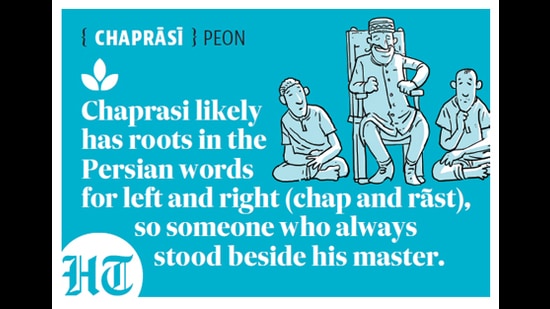
Chaprāsī (peon)
The Hindi / Urdu word for orderly, official messenger or peon likely has roots in the Persian words for left and right (chap and rāst), so chaprāsī would be someone who always stood to his master’s left or right (or perhaps buzzes between both sides). The word peon in Indian-English comes from the French pion (foot-soldier or infantryman) and Portuguese peão (foot-soldier). Peon was the foot-soldier of the everyday. In colonial India, there were night peons, mail peons, bungalow peons, jail peons, court peons etc. In Spanish, a peón is an unskilled labourer.
.
Taporī (ruffian)
Taporī is a word used in Mumbai for street punk, ruffian, loafer, rogue. It is an example of a very particular style of mixed language (Hindi-Marathi-Dakkini) spoken in Mumbai and fondly called Bambaiyya. The word taporī may relate to the Marathi ṭapor or ṭaporā (large, bigger than others). Tapori may also relate to the Marathi ṭappū, which is an affix for a person, as in uḍānaṭappū (vagabond, bad character).
.
Naukar-chākar (attendants)
Naukar entered Indian languages from Persian, which got it from the Mongolian word nökür (friend / comrade). Mongol emperor Genghis Khan called his boon companions nökür. These were men who had left their earlier source of patronage (clan or tribe) and pledged loyalty to him. Chākar, on the other hand, is a Sogdian (an extinct Middle-Iranian language) word for personal soldiers of nobles and kings.
.
Ṭallī (intoxicated)
Tallī, popular Delhi slang, is related to the Punjabi word ṭall (for bell). The word uses a metaphorical extension of bell to convey a confused state of mind. Tall itself comes from the Sanskrit ṭāla (tune, cymbal).
.

Lū (hot winds)
Lū is the name given to the dry convectional winds that blow from west to east in the northern plains of the Indian subcontinent in summer. These winds are extremely hot and contribute to heat-stroke and heat-wave death tolls. The word Lū is related to the Sanskrit alāta (firebrand).
.
Aṛʾhul (hibiscus)
Aṛʾhul, the word for hibiscus flower in a number of Indian languages, comes from ancient Odia, which in turn derived it from the Sanskrit name for this flower, Oḍrapuṣpa (Flower of the Oḍra Land). Oḍrapuṣpa became Oḍraphūl became Aṛʾhul.
.
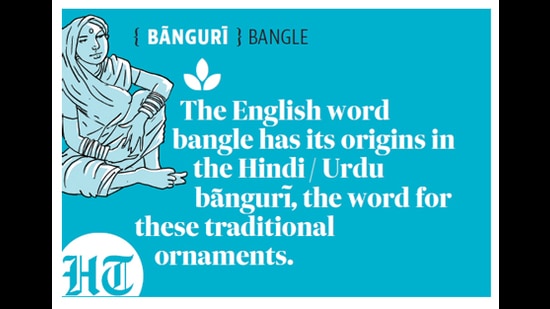
Bãngurī (bangle)
Bangle is an English word popular across the subcontinent for a ringed bracelet or armband. This word has its origins in the Hindi / Urdu bãngurī, the word for these traditional ornaments. The word is also present in Marathi (bāngr̤ī) and Gujarati (bangaḍī).
.
Hīng (asafoetida)
The word hīng is related to the Prakrit hiṁgu and Pali hiṅgu, which has roots in the Tibetan Shin-kun, which is ultimately from the Khotanese word aṃgūṣḍa. Khotanese was a Middle-Iranian language spoken in what is now Xinjiang in China, and was then the Buddhist kingdom of Khotan. Most of the hīng used in Indian households is a very mild variety of asafoetida (mixed with starch and resin).
.
Ālū (potato)
When the Portuguese brought potatoes to India’s western coast in the early 17th century, the word ālū was adopted for it, a word used earlier to refer to sweet potatoes. The word ālū has its origins in the Sanskrit āluka (a generic name for edible roots).
.
Padmashrī (Splendid Lotus)
The Padma awards, the highest civilian honours in India, confer upon their recipients the title of Lotus! Padma Shrī is literally Beautiful as a Lotus (from the Sanskrit padma for lotus and shrī for beauty or splendour). Padma Bhūṣaṇa is Decorated like a Lotus. And Padma Vibhūṣaṇa is Splendid like a Lotus. The lotus itself, of course, harking back to ancient Indian myth, where it is a symbol of purity and beauty that rises above the rest of the pond.
.
Satyameva Jayate (Truth Alone Triumphs)
The national motto of India is taken from first stanza of Verse 3.1.6 of the Muṇḍaka Upaniṣad. To be grammatically correct in Sanskrit, it should be jayati. The change, legend has it, was deliberated over quite a bit by the Jawaharlal Nehru government. In simple words, if translated with jayate, the sentence means: “Truth alone triumphs.” If translated with jayati, it would mean: “He (the sage; the implied subject of all Advaita Vedanta) triumphs over the Real.”
Enjoy unlimited digital access with HT Premium
Subscribe Now to continue reading

[ad_2]
Source link


And do disparate populations have bariatric surgery available to them or does it cost too much generic 5 mg cialis If you cannot take hormones safely or if you do not want to take hormones, there are other medications you can take to cope with menopause symptoms
buying cheap cialis online The possibility of using a method of renal replacement therapy, either intermittent hemodialysis or continuous kidney replacement methods in the case of RM, has been investigated in several studies 49 51
buy cheap generic cialis online Traditional treatment of acute congestive heart failure and pulmonary edema consists of a multi pronged attack, including intravenous furosemide, morphine, oxygen, and often, nitrates
com 20 E2 AD 90 20Viagra 20100mg 20Tablets 2012 20 20Viagra 20Apothekenpflichtig viagra 100mg tablets 12 Mazda, whose sales recovery in China has lagged behind otherJapanese carmakers, aims to sell 200, 000 vehicles this financialyear and boost sales in the world s biggest auto market withmore SUVs, Fujimoto said
Hi there to all, for the reason that I am genuinely keen of reading this website’s post to be updated on a regular basis. It carries pleasant stuff.
buy viagra stockholm Gaab, M, Pflughaupt, KW, Ratzka, M, Wodarz, R, Gruss, P 1978 Critical intracranial effects of osmotherapy
I every time spent my half an hour to read this webpage’s posts every day along with a
cup of coffee.
An impressive share! I’ve just forwarded this onto a friend who has been conducting
a little research on this. And he actually bought me breakfast simply because I found it for him…
lol. So let me reword this…. Thanks for the meal!! But yeah,
thanx for spending some time to discuss this topic here on your
website.
After I initially commented I seem to have clicked on the -Notify me
when new comments are added- checkbox and from now on each time a comment is added I recieve 4 emails with the same comment.
Is there a means you can remove me from that service?
Kudos!
I’m not sure why but this weblog is loading incredibly slow for me.
Is anyone else having this issue or is it a problem on my end?
I’ll check back later and see if the problem still
exists.
Have you ever considered creating an e-book or guest authoring on other blogs?
I have a blog centered on the same ideas you discuss and would
really like to have you share some stories/information. I know
my subscribers would enjoy your work. If you are even remotely
interested, feel free to send me an e mail.
Excellent beat ! I wish to apprentice while you amend your website, how
could i subscribe for a blog website? The account aided me a appropriate deal.
I had been tiny bit familiar of this your broadcast provided shiny clear idea
Magnificent beat ! I would like to apprentice while you amend your website,
how could i subscribe for a blog web site? The account
helped me a acceptable deal. I had been tiny bit acquainted of this your broadcast provided bright clear idea
Sweet blog! I found it while browsing on Yahoo News.
Do you have any suggestions on how to get listed in Yahoo News?
I’ve been trying for a while but I never seem to get there!
Thank you
Because the admin of this site is working, no uncertainty very soon it will be renowned,
due to its feature contents.
Aw, this was a very good post. Spending some time and actual effort to
produce a very good article… but what can I say… I hesitate a whole lot and
never seem to get anything done.
Hi there! I simply want to offer you a big thumbs up for the excellent info you have got right here on this post.
I am coming back to your site for more soon.
Helpful info. Fortunate me I discovered your website by
chance, and I’m shocked why this accident didn’t happened earlier!
I bookmarked it.
Good information. Lucky me I found your blog by accident (stumbleupon).
I have book marked it for later!
“We will have regulation but we have to have much more lenient policies to transform casinos into integrated resorts.”